Around here, there comes a time during March when just a few small things start to stir. Small things with six legs and small things with eight legs too.
Today is as good a time as any to talk about spiders (and mites). Specifically, some of the species of spiders that live in our garden, parks and homes. This topic was brought to mind when our town’s environment officer asked me a few days ago how many spiders I had personally recorded in the town … a town which, by the way, is tiny in area and population. I keep prodigious personal records, but was surprised to learn the number, once I had totted it up, as you will learn if you read on.
Spiders are fascinating creatures - so many species, each with unique features. They produce silk stronger than steel, and exhibit intriguingly complex mating rituals and sophisticated hunting techniques. I know some people don’t like them but really, there is no reason to be squeamish or afraid. Most species are harmless to humans and they play vital roles in ecosystems by controlling insect populations. “But they bite!” … rarely if ever and anyway, the majority of spider bites are less harmful than a bee sting. Spiders are small (mostly) and for very good reasons they need to be more afraid of us than we are of them.
There is a significant ecological role that spiders play, which can help mitigate any fears. For example, spiders are predators. According to a study published in the journal Science, worldwide spiders consume an estimated 400-800 million tons of prey annually, which includes a variety of insects harmful to crops and human health. Spiders are considered bioindicators, meaning their presence and diversity can reflect the health of an ecosystem. Changes in spider populations can indicate shifts in environmental conditions, such as habitat degradation or climate change and can help us notice and protect our natural environments.
For a lot of people, even the relaxed “I can take them or leave them” types, spiders are to much more than either big or small, inconsequential, or creepy/scary, and that’s as far as it goes. Then there are the small subset, like me, who get down on our hands and knees and have a close look - ideally assisted by a camera. Taking that approach my personal in-town spider list has reached the dizzy heights of 28 different species. A good number of those were quietly going about their business in the garden or nearby parks and a few live indoors alongside us. I will list them in a bit but there is no exam at the end … there will be some pictures however.

Our local “creatures with eight legs” fall primarily into the three Orders of True Spiders, Harvestmen, and Mites plus Ticks.
True spiders (Araneae)
Arguably the most recognizable of all the arachnids, representing predators that are broadly categorized into web-building and free-living groups. They are distinguished from other arachnids by use of silk, and the use of venom to subdue prey. These arachnids have evolved into a many, many different forms, but the basic arachnid body plan remains unchanged in all spiders. There are over 45 000 species worldwide, with only a few of medical/toxic significance, and none of those are around here.
Some spiders are large and some are small. Obviously, the larger species are the ones that people who have a phobia worry about, simply because they loom at you. Perhaps the ones that causes more worry than others are the very common – they are in all our gardens – such as the Wolf Spider and the Dock Spider and the Fishing Spider. Local species in those groups include the gloriously named Drumming Sword Wolf Spider (Gladicosa gulosa) though that is mostly nocturnal and not too common. We do, however, have several species of the genus Pardosa or Thin-legged Wolf Spiders. Despite their name, they are not that large.

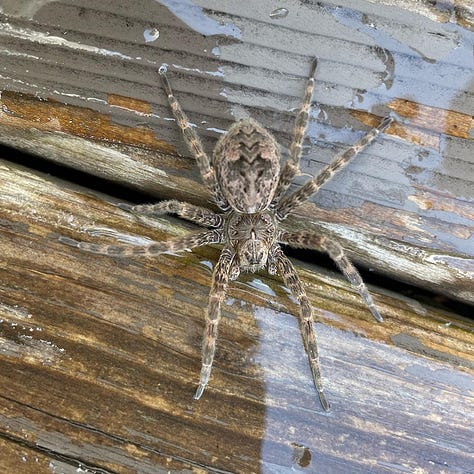
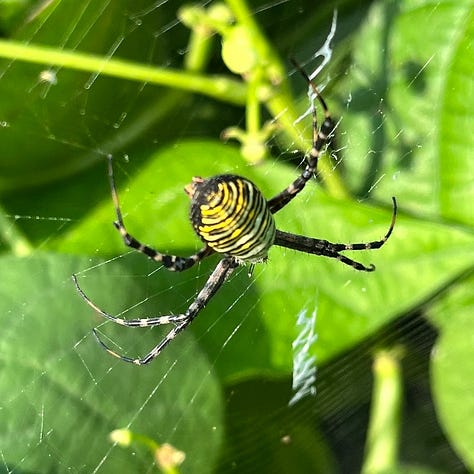
Dock Spiders and Fishing Spiders are the big guys that lurk under logs and in dark crevices. Most of these are species in the genus Dolomedes . Some species can be as much as three inches across. They don’t spin webs to catch prey but stalk their meals and have wide tastes. They will catch and eat all sorts of tasty creatures, including insects, but also tadpoles and small fish such as minnows. Not only that, but they are one of the few invertebrates that eat vertebrates, though they have no interest in eating us. Take a deep breath if they worry you, and just quietly watch these fascinating creatures.
Some other spiders that are easy to find are Grass Spiders (genus Agelenopsis), Orbweave spiders like the very common Cross Orbweaver (Araneus diadematus) and the unmissable late summer Yellow Garden Spider (Argiope aurantia).
The Orb Weave Spiders and the Yellow Garden Spider are the group that spin the classic spiders’ web to catch their prey. Grass spiders spin a web too but make a funnel shape to catch their meals with. The Yellow Garden Spider is quite large and colourfully marked, and so is easy to see. It spins the classic spider’s web and then hangs in the middle looking hopeful. Although not unique to this species, its webs are adorned with a distinct “zipper” – named a stabilimentum the actual purpose of which is still a matter of uncertainty. In houses and buildings as well as outdoors you will some across some smaller spiders, including the Northern Yellow Sac Spider (Cheiracanthium mildei) and the quite common Eastern Parson Spider (Herpyllus ecclesiasticus) . The Parson Spider takes its name from a mark on its abdomen that is said to look like the stock or cravat worn by the clergy a couple of centuries ago. It is actually a woodland species, but they like to come indoors where they will hide in cracks and behind cupboards. If trapped in clothing for example it may give a small nip, but it’s a small spider, so you will probably not notice—on the other hand it feeds off insects you would probably rather not have in the house so should be a welcome guest.

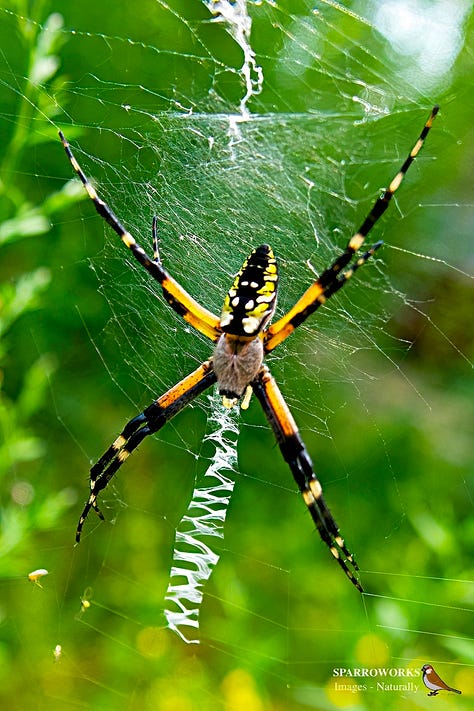

Opiliones – Harvestmen
Opiliones, or harvestmen, are arachnids that possess neither venom nor silk and are most commonly found in wooded areas. They look somewhat like spiders but are not. Harvestmen have a small body with a fused thorax and cephalothorax (abdomen), lack venom glands and silk glands, and are completely harmless to humans. Harvestmen are predators that actively hunt for prey, feeding on eggs, soft-bodied and dead insects. The first and second pairs of walking legs are used as tactile sensory appendages, while walking is usually done with just the third and fourth leg pairs. More than 6,500 species are described worldwide, of which we have perhaps three, one of those being an import from Europe.
There are two common species you will come across. European Harvestman (Phalangium opilio) and the native Eastern Harvestman (Leiobunum vittatum).
And then there are the Acari – Mites and Ticks
This is the most diverse arachnid order, with at least 55 000 species. Acariform and parasitiform groups are commonly recognized, the latter including the predatory mites and ticks. The abdominal segments are fused and extremely difficult to distinguish, resulting in the appearance of an unsegmented abdomen. They can occupy a wide range of habitats and lifestyles including free-living predators, detritivores, saprophages, phytophages and ectoparasites.
There are probably thousands of mites within feet of where you are sitting now, but they are mostly very tiny and living in the soil. In summer, the easiest and most reliable way to add a Mite to your life list is to look for leaf galls on trees. In most years there are plenty of galls caused by Aceria querci, the Oak Leaf Gall Mite.
Ticks … you didn’t really want to get too close to some of these fellows, but they are out there. Almost all the reports that I have found are for two species -
Ixodes scapulari, the Eastern Black-legged Tick or Deer Tick and Dermacentor variabilis, the American Dog Tick. There is a single report of Ixodes cookei the Groundhog Tick, but you are really unlikely to see that.
The Deer Tick, is, of course, the species responsible for spreading Lyme disease. You might find that one on your skin without even trying to look for them. Be careful.

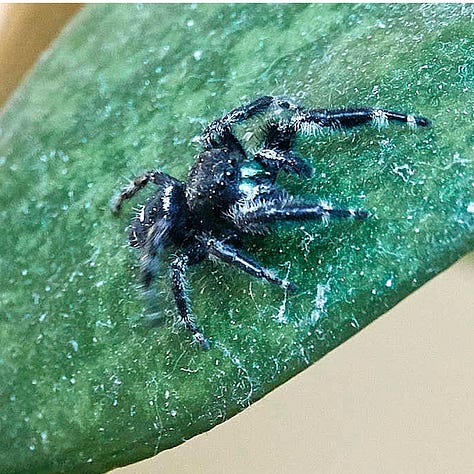

A friend shared this - no idea who the artist is, but I liked it:
If you have got this far I will reward you with the 28 spider identities …
Cross Orbweaver, Cellar Spiders, Cross Orbweaver, Gall and Rust Mites, Willow Bead Gall Mite, Oak Blister Gall Mite, Plum Finger Gall Mite, Dark Fishing Spider, Leafcurling Sac Spiders, Banded Garden Spider, Grass Spiders, Yellow Garden Spider, Common Pirate Spider, Ground Crab Spiders, Goldenrod Crab Spider, Running Crab Spiders, Genus Pelegrina, Grass Spiders, Eastern Harvestman, European Harvestman, Genus Eustala, Northern Yellow Sac Spider, Longlegged Sac Spiders, Eastern Parson Spider, Candy-striped Spider Complex, Zebra Jumping Spider, European Harvestman, Bold Jumping Spider
Introduce children to wildlife
Another very sound article from The Guardian. I don’t worry about dinosaurs but I am more than 100% with the author when it comes unicorns and the like.
If they want monsters, tell them about the Gila monster that lives in Mexico and the south-western US. If they want magic, tell them about chameleons that are alive now in Madagascar and can change colour. Tell them about beautiful peacock spiders, whose eight eyes are so big that they take up almost their entire heads.
If children become curious about insects, they won’t grow up with a fear of them. If you show children how intelligent octopuses are, when they are adults maybe they will choose not to eat them. If you tell them stories of orange orangutans then maybe as adults they will want to visit Borneo and play a part in protecting the rainforests – or at least they will avoid buying palm oil. If you want to start nearer home, maybe you know someone who has raccoons in their garden, snuffling around at dusk?





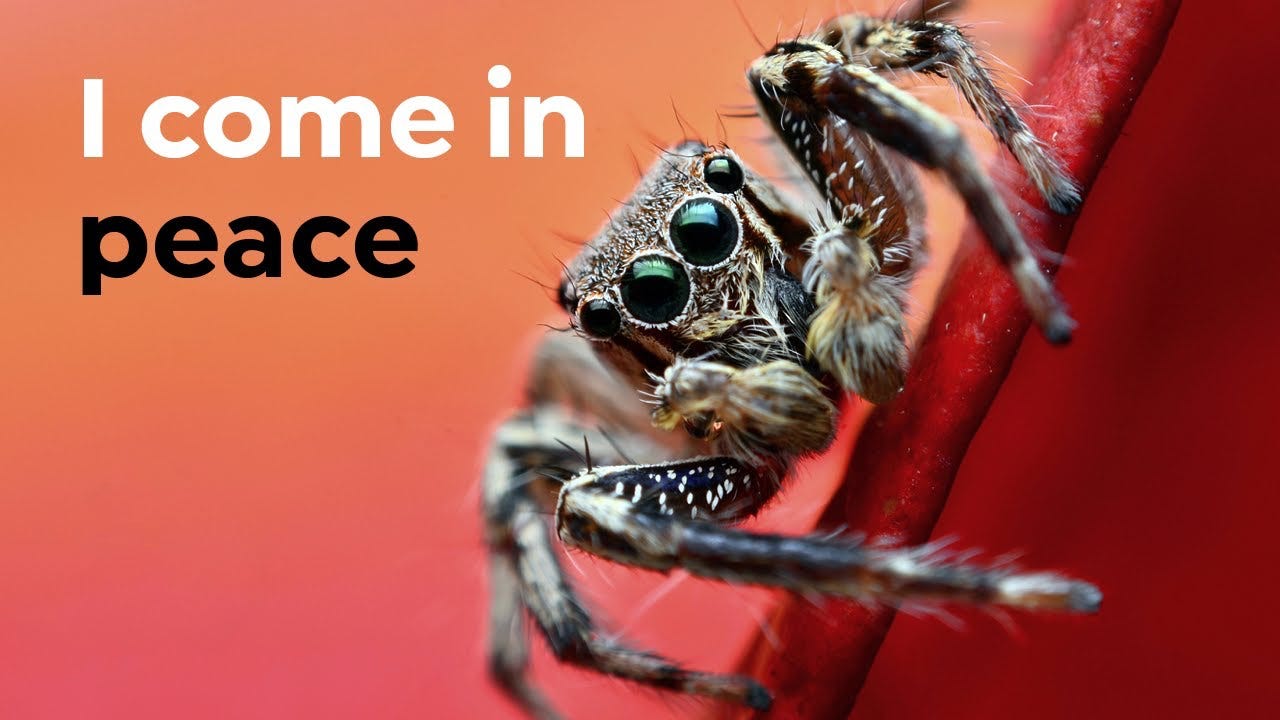



Excellent article. I'm fascinated by spiders and harvestmen. The only time I don't like spiders is when I find them somewhere totally unexpected.
Proud to be the first to comment! Who wouldn't want to expound on spiders? Not I! In our drafty tumbledown Victorian hovel there is an ecosystem of sorts and spiders play an important part. They wander in and out through points of ingress and egress unknown. Being Buddhists we dislike killing them so arrange to trap and export them, persona somewhat non grata, to the great out-of-doors where likely they find things congenial but also, if the weather be chilly, find their way back in again.
What part do they play? Depending on the season, we have very tiny ants who have their own ports of entry, pursue their aims, and are generally ignored by all. Then there are the small clothes moths, again seasonal, who flutter about and are exceedingly adept at evading human capture but who can be eaten by the spiders. Then there are those myriapede beasties which may ingest spiders or moths as the case may be- I'm not at all sure. Finally there are the lumbering humans, chasing none, eating none, just attempting to keep the harmonious little house from being overrun. What could be nicer?